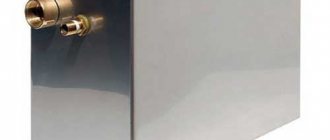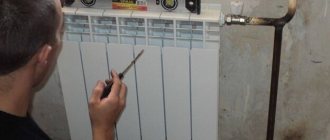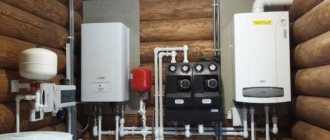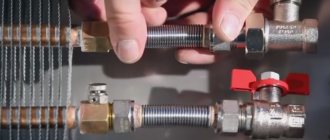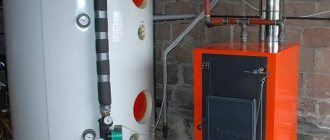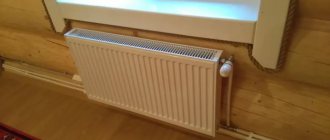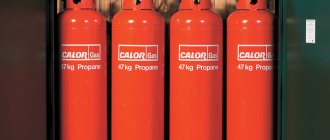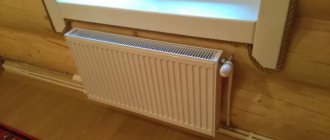Heating with electricity will not cost too much if you choose the right heating system and insulate the garage. Even the most economical electric boiler for heating a garage will “heat the street” if the walls, gates and roof are not insulated.
On the one hand, sudden temperature changes in winter accelerate metal corrosion. But, if you organize good ventilation in the garage, then in a warm room there is no need to warm up the engine, and there are no cold starts that are harmful to the engine.
Two heating systems
There are two fundamentally different heating systems that can be used to heat a garage:
- air;
- water
Air heating is carried out using electric fan heaters, convectors, and oil radiators. This is the simplest heating method. To heat the air in the garage you will need a heating device and an electrical connection. However, after turning off the device, the temperature in the garage drops quickly. This type of heating is suitable if the car owner is in the garage occasionally and spends little time there.
Schematic diagram of water heating
The water system is more reliable. However, when installing it you will have to spend more money and labor. It includes three main parts:
- pipes through which the coolant circulates;
- heat emitter into space (battery);
- coolant heater.
Antifreeze is used as a coolant, since the heating in the garage is turned on periodically, and pipes filled with water can burst when frozen.
Heating boilers are used to heat the coolant. They can be of different types:
- gas;
- electrical;
- solid fuel;
- liquid fuel.
Economical heating, fuel options
If you decide to make your garage heated, it is worth considering various solutions.
Elimination of heat loss
The first step to help get rid of the cold is to eliminate excessive drafts. It is advisable to use acrylic silicone or polystyrene foam for window frames, because the window is the source of valuable heat loss.
Owners of a metal garage have a little more concern, where the connections of structural elements are rarely precise. A sealed garage is not an absolute blessing. The point is the moisture present here in abundance. Lack of ventilation contributes to dampness and corrosion of the car’s sheet metal. It is necessary to maintain minimal ventilation by temporarily opening a window or door.
Electric garage heating
A common choice is portable heating. A popular inexpensive heating device is electric heaters. Electric heaters consist of a heater and an axial fan, which is responsible for the rapid distribution of heat in the room. Heaters for garage use typically have a metal body with a plastic handle for easy transportation. Small size and weight are the main advantages of electric heaters. When choosing a heater, you should find out whether it has adjustable power and a thermostat.
Heaters for technical premises around the house are distinguished by increased thermal power compared to their domestic counterparts. Small heaters convert 3-5 kW of electricity into heat, allowing you to effectively heat rooms of 20-25 square meters. Basic models of modern heaters can be purchased at an attractive price. Due to the high electrical current consumption, such heating is quite expensive.
Gas heating
The use of gas heat guns is more effective than electric heating. Gas fuel is supplied from a propane or propane-butane cylinder. Due to the high calorific value of raw materials and oxygen combustion, gas heaters achieve extremely high heat output - up to several tens of kilowatts.
Cheap gas heaters with a thermostat cost 1.5-2 times more than an electric heater.
Gas devices are designed for heating open spaces and rooms with good ventilation. They do not require chimneys; it is necessary to provide air flow to ensure combustion. Gas heaters are used for heating workshops and large garages and workshops, where energy-efficient devices are required to quickly achieve the desired temperature in a short period of time. Gas heaters are ideal for indoor plants - when they burn oxygen, they release carbon dioxide, which is necessary for photosynthesis. The device must be equipped with:
- electrovalve,
- flame control.
Waste oil furnace
If you have access to a large amount of waste, you can heat your garage using an oil furnace. This is a popular solution to the issue of cheap heating. The performance of waste oil furnaces is similar to that of gas heaters. The furnace can easily raise the temperature even in large workshops.
Cheap stoves can be bought for 25,000 rubles. It is worth considering choosing a stove with a closed combustion chamber and chimney. This is a convenient, safe solution.
Waste oil furnaces are the least mobile of all the devices considered due to their high weight. Luckily, many portable stoves are mounted on a mobile stand.
Video
Conclusion Many car owners wonder whether garage heating is necessary. It is not always necessary to heat a given room. In winter, it is still much warmer in the garage than outside, we will protect the car from ice and snow, and we will save time that you have to spend in the morning cleaning the car, warming up the engine, and the interior in severe frosts. Even in a detached garage, the temperature will only drop below freezing when the frost lasts for a while. Heating a garage requires insulating the walls, roof, windows, and gates.
To choose the right type of heating, it is important to correctly assess the expected intensity of use, the size of the room:
for periodic heating of the room, electrical equipment is recommended; in large rooms, workshops, auto repair shops, it is better to pay attention to gas and oil heaters
Pros and cons of electric boilers
Each type of boiler has its own disadvantages and advantages. The most optimal heat generator in modern conditions is an electric boiler.
Electricity is available everywhere, in cities and rural areas.
There is no need to install a chimney, buy and store liquid or solid fuel in the garage, or clean the boiler from soot.
Electric boilers are compact and easy to install
Electric boilers are very easy to use. Modern control systems allow them to operate automatically. They make it possible to turn on the heating without entering the garage.
Another advantage is ease of installation. Installing an electric boiler for heating a garage with your own hands is not difficult if you have minimal technical knowledge and work skills.
Electric boilers do not create an open flame to heat water or other coolant. This means they are safer from a fire safety point of view.
The efficiency of new models reaches 99 percent.
They are economical because automation allows you to smoothly regulate their power, thereby reducing energy consumption.
Finally, it should be noted that the industry offers a wide selection of electric boilers of various capacities, designs suitable, as they say, for all occasions.
There are far fewer disadvantages. It may be necessary to install additional wiring when installing a three-phase boiler. The electrical network to which the boiler is connected must have sufficient power for safe operation.
The price of the energy source remains controversial. Some critics point to the high cost of electricity. But prices for gas, electricity and other fuels are constantly changing, so it is difficult to give an unambiguous assessment.
Calculation of consumption based on housing characteristics
An electric boiler does not always exactly match the heating energy needs of a home. Often its power is selected with a reserve. Here are some examples of such scenarios:
A dual-circuit device provides the house with hot water;
The power of a double-circuit boiler is excessive, since it must provide the house with hot water. Including during the heating season.
- It is planned to add additional rooms to the house with the connection of heating devices in them to the existing circuit;
- The region is characterized by rare but severe frosts, and the heating system is designed specifically for them.
If the boiler power is obviously excessive, you will have to focus not on it, but on the actual heat consumption of the house. Most accurately, it can be calculated using the formula Q=V*Dt*k/860.
The variables in this formula from left to right are:
- Energy consumption (kW);
- The volume of the room that needs to be heated. It is indicated in SI units - cubic meters;
The volume of a room is equal to the product of its three dimensions.
- Difference between indoor and outdoor temperatures;
- Insulation coefficient.
Where do I get the last two parameters?
The temperature delta is taken equal to the difference between the sanitary norm for the room and the coldest five days of winter.
You can take sanitary standards for residential premises from this table:
| Description | Temperature norm, C |
| A room in the center of the house, the lowest winter temperature is above -31C | 18 |
| A room in the center of the house, the lowest winter temperature is below -31C | 20 |
| Corner or end room, lower winter temperature above -31C | 20 |
| Corner or end room, lower winter temperature below -31C | 22 |
Sanitary temperature standards for non-residential rooms and common areas.
And here is the temperature of the coldest five-day period for some cities of our great and vast:
| City | Value, C |
| Khabarovsk | -29 |
| Surgut | -43 |
| Smolensk | -25 |
| Saint Petersburg | -24 |
| Saratov | -25 |
| Petrozavodsk | -28 |
| Permian | -25 |
| Eagle | -25 |
| Omsk | -37 |
| Novosibirsk | -37 |
| Murmansk | -30 |
| Moscow | -25 |
| Magadan | -29 |
| Kemerovo | -39 |
| Kazan | -31 |
| Irkutsk | -33 |
| Ekaterinburg | -32 |
| Volgograd | -22 |
| Vladivostok | -23 |
| Vladimir | -28 |
| Verkhoyansk | -58 |
| Bryansk | -24 |
| Barnaul | -36 |
| Astrakhan | -21 |
| Arkhangelsk | -33 |
Distribution of winter temperatures across Russia.
The insulation coefficient can be selected from the following range of values:
- A house with an insulated facade and triple glazing - 0.6-0.9;
- Two-brick walls without insulation and double-glazed windows - 1-1.9;
- Brick walls and single-strand glazed windows - 2 - 2.9.
Example
Let's calculate the electricity consumption for heating with our own hands for a month for the following conditions:
House size: 6x8x3 meters.
Climatic zone: Sevastopol, Crimea peninsula (the temperature of the coldest five-day period is -11C).
A rubble house with single glazing requires intense heating in winter.
| We calculate the volume. 8*6*3=144 m3. |
| We calculate the temperature difference. The sanitary standard for a private house (warm region, all rooms are at the end or corner) is 20C, the temperature of the coldest five days of winter is -11. Delta - 20 - -11 = 33C. |
| We select the insulation coefficient. Thick walls made of rubble stone with its high thermal conductivity and single glazing give its value around 2.0. |
| Substitute the values into the formula. Q=144*33*2/860=11 (rounded) kilowatt. |
We also went through the technique of further calculations:
- The boiler will consume an average of 5.5*24=132 kWh per day;
- It will consume 132*30=3960 kilowatt-hours of electricity per month.
Switching to a two-tariff meter will allow you to slightly reduce heating costs.
Types of electric boilers
Depending on the heating method, boilers are divided into three types:
- heating elements;
- electrode;
- induction
Boiler on heating elements
Boilers of the first type have been known for a long time and are widespread. The heating element is heating elements (tubular electric heaters), made in the form of a spiral. An electric current flows through the heating elements and they heat up. The heat is transferred to the coolant, which is supplied to the system using a pump and circulates in it.
Disadvantage - heating elements can overheat and burn out if there is a lack of coolant. New heating elements electric boilers are necessarily equipped with protective devices that cut off the power supply if the coolant level in the system is insufficient.
Electrode boiler device
An electrode boiler works on a different principle. Electricity in such a boiler is supplied to electrodes made of special alloys. The coolant acts as an element of the electrical circuit. It has a certain resistance, so the current passing through the coolant heats it.
Such boilers must have good grounding. If it is missing or poorly made, the risk of electric shock increases.
The main elements of an induction boiler are an electromagnetic coil and a heat exchanger. It consists of a metal core inserted inside the coil. When electricity is supplied to the coil, an alternating electromagnetic field appears in it. It creates eddy currents in the core that heat it. Next, the heat is transferred to the coolant.
Induction boiler SAV
Boilers differ according to the design of the body:
- wall;
- floor
Wall-mounted boilers are smaller and more compact. Floor-standing modifications are designed for boilers through which a larger amount of coolant passes.
Based on the electrical voltage, boilers are divided into:
- single-phase;
- three-phase.
In the first case, the operating voltage is 220 volts, in the second case - 380 volts. Boilers with a power of up to eight kilowatts are made single-phase. In the range of 8-12 kW you can find devices of both modifications. If the power is more than 12 kW, the boilers are available in three-phase versions.
Boilers are manufactured with different types of power regulation. Power adjustment allows you to change the heating temperature of the coolant and energy consumption.
Power can be adjusted:
- smoothly;
- by steps.
With stepwise adjustment, heating elements independent of each other are turned on and off.
Smooth regulation is done using a rheostat.
Low-power boilers of simple designs do not provide for adjustment of this operating parameter.
Electric boilers come in different configurations. An electric boiler without additional elements (pump for circulating coolant, safety valve, expansion tank, cleaning filter) is cheaper. But it is better to purchase boilers with a complete set. The listed items will have to be purchased separately, and in the end the cost of money may be large.
Types of heating devices
Heating gas is used in the following ways:
- Full heating with boiler. It heats the water circulating through the pipes. Gas service workers themselves must connect the system to the main wire. To do this, you will need to sign the relevant documents and pay the price for the insert.
- Boiler for heating air. Heating in this case is carried out using a heat gun. With this method, the gas burns out in a burner, and heat fills the room through a fan.
Gun for organizing garage heating
- Condensing boiler - economical heating of a garage space. The efficiency is approximately 10% greater compared to conventional gas ones.
The first method is the most difficult, since it takes time to collect, prepare documentation, create a project, and install heating. In addition, you should select, buy, and install a boiler.
For the second method, no special equipment is needed; it is enough to use liquefied gas from a cylinder.
Gas-burner
A burner is an easy way to heat a garage; it is the most affordable method that helps maintain a comfortable temperature in a small room. The burner is easy to operate and meets heating needs even in winter.
There is no need for a chimney under the burner, because during operation it does not release harmful impurities into the space. But a constant supply of fresh air is important.
The burner is an infrared heater, so the heating does not spread in a narrow direction. This is extremely convenient if you need to stay warm and quickly warm up your work area. For uniform heat distribution, you will need to wait about 30 minutes - depending on the power of the device. Fuel consumption (in this situation, gas) is minimal. One cylinder is enough for several days of operation of the device.
Gas-burner
Do not leave the burner on unattended. In other cases, this is a simple, accessible and economical method.
Gas gun
A good heating method is using a gas gun. You just need to choose the right power of the device, this will allow you to maintain highly efficient heating.
The principle of operation of the gun is similar to the operation of a hair dryer. The basis of the device is a fan, the degree of heating is changed by a thermostat located on the body. The fan helps create a directed flow of air passing through the heating element. The heated air flows out, and the gun absorbs a new portion to warm up.
For garages, it is better to purchase a mobile cannon with wheels so that you can always move it to the right place. When using, please note that the device should not be constantly turned on. The garage only warms up to the desired temperature, then the gun is turned off. An important advantage of the device is its efficiency, because only 500 ml of liquefied gas is consumed per hour.
For maximum efficiency of the device, it is important to decide on the choice of a model that is suitable in terms of power. The performance of the device is calculated: 1.4 kW of power for every 10 square meters of room area, if the ceiling height is approximately 2.5 m. Typically, 3 kW of power is enough for a standard garage.
If there are often frosts in your region of residence, you should buy a gun with a capacity of 5 kW. The disadvantage of the device is poor environmental friendliness, because during combustion it releases toxins into the environment.
Gas heater
A heater that runs on bottled or natural gas can be mobile or stationary. Mobile devices are small in size and benefit from their local heating. Stationary devices can operate from the main wire or from a cylinder.
There are no special devices designed only for garages. You should choose taking into account the available assortment. For a garage space, 4 different types of gas heaters are suitable.
Heater
The devices and functions of each are interconnected, because heating in them is carried out according to similar rules:
- first, gas is supplied to the combustion chamber;
- at this stage the gas is ignited using a piezoelectric element;
- fuel combustion products enter the chimney through a special pipe - this is how stationary models are designed;
- heat during combustion affects the heating element, heats it up; the heating element can be ceramic or steel.
Subsequently, the process differs depending on the type of device.
Gas convector
When there is no water in the garage, there is no possibility of connecting to the main line through which gas passes, then the best choice is heating through a convector. For a room of a standard area, just one convector is enough. It economically consumes gas from the cylinder, requiring less costs in contrast to the column or boiler.
During the installation process, you will only need to spend money on a good convector, because radiators and water pipes are not needed. It is better to mount these devices on a vertical wall that is not located adjacent to other buildings.
This placement will help create high-quality heating and safely place the cylinders outside the garage room on the street. The optimal solution is to install the cylinders in a special metal box near the wall, behind which the convector will hang. When all the walls are located adjacent to adjacent buildings, the solution is to place the box with cylinders inside the room, but as far as possible from electrical appliances. There must be holes made in it for ventilation.
A gas boiler
The efficiency of many modern boilers is close to 100%. These are economical devices. For example, a top class boiler is characterized by an efficiency of 94-96%. The efficiency of a middle class boiler is 70-90%. The cost of premium equipment is an order of magnitude higher than average.
Boiler
Professionals advise not to focus on price; you should not purchase the most affordable models, since the difference in price will quickly pay for itself during operation. A cheap boiler will need to be replaced after a couple of years or constantly spend money on repairs and constant maintenance. As a result, the total costs will be much higher in contrast to premium models.
The service life of boilers in the middle price segment is 10-15 years, but more expensive options will last at least twice as long.
The purchased model must be equipped with automatic control. Modern boilers are easy to use, they are completely safe, reliable, and are distinguished by the ability to set a comfortable temperature regime. You can choose even the smallest gas boiler, but it is still very powerful.
Choosing an electric boiler
The choice begins with determining the required power. This is not difficult to calculate. There is a classic ratio: to heat 10 square meters of an insulated room, the ceiling height of which is not higher than three meters, you need one kilowatt. Thus, you need to calculate the garage floor area. If it is, for example, 30 sq. m., then you need a device with a power of at least 3 kW. Next, you need to make an adjustment of 15-20%, as they say, in reserve. As a result, the optimal power is 4 kW.
Therefore, the boiler will be single-phase. There is no need for additional wiring.
However, the above does not mean that it is impossible to install a boiler of higher power. In this case, heating will occur faster, but the cost of a more powerful device will be higher and electricity consumption will increase.
The next parameter influencing the choice is price. It depends on the degree of advancement of the device. The more electronic filling with increasing functions, the higher the price. Whether extensive functionality is needed is up to the garage owner to decide. It should be noted that the more complex the device, the more likely it is to fail.
The most expensive are induction, followed by heating elements in next place in price. The cheapest are electrode boilers.
The next parameter is the manufacturer. The brand of a well-known manufacturer is a guarantee that the boiler will operate reliably and provide heating in accordance with the characteristics specified in the technical data sheet.
Insulation of the garage
Before installing heating, it is necessary to properly insulate the garage, since heat leaks through the floor, roof, walls and doors significantly reduce heating efficiency and increase costs. Insulation is carried out using thermal insulation materials (mineral wool, polystyrene foam, polyurethane foam). Garage door leaves are sealed with special seals for this purpose.
Electrical connection diagram
Buying Tips
When choosing an electric boiler for heating a private home, you should pay attention not only to reviews and electricity consumption, but also to other parameters. 1. Installation method
In an apartment or small private house, it is optimal to install a wall-mounted boiler. They look aesthetically pleasing, fit neatly into the interior of the home, and at the same time are capable of producing significant temperatures. As for floor-standing options, they can be classified as industrial or semi-industrial models. These are units for large households with a power of 24 kW
Installation method. In an apartment or small private house, it is optimal to install a wall-mounted boiler. They look aesthetically pleasing, fit neatly into the interior of the home, and at the same time are capable of producing significant temperatures. As for floor-standing options, they can be classified as industrial or semi-industrial models. These are units for large households with a power of 24 kW
1. Installation method. In an apartment or small private house, it is optimal to install a wall-mounted boiler. They look aesthetically pleasing, fit neatly into the interior of the home, and at the same time are capable of producing significant temperatures. As for floor-standing options, they can be classified as industrial or semi-industrial models. These are units for large households with a power of 24 kW.
2. Method of connection to the electrical network. Economical low-performance electric boilers are plugged into a regular 220 V outlet. But for units of medium or high power, it will be necessary to install a three-phase 380 V network. A regular 220 V network will not support such a load.
3. Number of connections. Here is the standard classification: single-circuit and double-circuit models. The former are exclusively for heating, the latter, in addition to this, also heat water for the water supply.
4. And yet the main indicator is productivity. It determines the energy consumption and heating area. Standard minimum – 100 W per square meter
Please pay attention to this point: the worse the thermal insulation of your home, the more powerful the boiler you will have to buy, and, accordingly, the more you will pay for electricity later
A few more landmarks. The current should be limited to a maximum of 40 A. Electric boiler pipes are 1 ½″ or more. Pressure – up to 3-6 atmospheres. A power control function is required - at least 2-3 steps.
Be sure to inquire about the quality indicators of the local power supply - if the voltage drops to 180 V in the evenings, the imported model will not even turn on.
Before buying an electric boiler for 10-15 kW or higher, find out whether the transformer from which the house is powered will handle it. Otherwise you will have to lay an additional line to your estate.
As for specific models, the most popular are imported ones, since they provide high performance with minimal power. Among the most popular, according to sellers' reviews, are:
- wall-mounted, single-circuit Tenko KEM, 3.0 kW/220V, cost around $45-55;
- wall-mounted, single-circuit UNIMAX 4.5/220, cost $125-200;
- wall-mounted, single-circuit Ferroli LEB 12, 12 kW, price – $350-550;
- wall-mounted, single-circuit Protherm Skat 9K, 9 kW, cost $510-560.
Popular models
- One of the most popular models is EVAH C1 7.5 220. The heating elements are made of stainless steel. If they fail, they are very easy to replace. The temperature is regulated by a built-in thermostat. It is possible to use a remote thermostat. Two-stage protection against coolant overheating is provided. Very easy to install. The disadvantages include the lack of a pump.
- The heating elements and bodies of the ZOTA 12 Lux boilers are made of stainless steel. The body is finished with vinyl wallpaper. The boiler is light in weight and dimensions, which makes it easier to choose where to install it. Connection for heated floors is provided. An easy-to-use control panel makes it easy to configure the operation of the device. Cons: lack of a pump included and noise during operation.
- The RusNIT 270 boiler can be used to heat both a garage and any other residential and domestic premises. It is possible to connect a boiler, heated floors, a room thermostat, and a GSM module.
A module is a small device that processes and transmits information from the boiler to the user and vice versa in the form of text messages. It is needed for a quick response to changes in the operation of the autonomous heating system.
Sensors that monitor the temperature and filling level of the system make the operation of the electric boiler completely safe. There is a three-stage power adjustment (30%, 60% and 100%).
- The Protherm Skat 6K boiler has a very high efficiency (99.5%). The temperature in the heating circuit is adjustable in the range from 30 to 85 degrees. The heat exchanger is made of stainless steel. Equipped with all necessary automation. A very convenient display that shows all operating parameters. The disadvantage of boilers from this company is their somewhat inflated price.
You can purchase good boilers from other manufacturers (Kospel, Dakon, etc.).
Craftsmen can make a boiler themselves, but this is only for people who have the necessary skills.
Electric boilers have a whole range of advantages when installed in a garage compared to fuel-fired boilers. They are compact, easy to install, easy to operate and maintain. The only limitation for use can be the insufficient power of the electrical network, but since most garages do not require powerful electric boilers for heating, this obstacle is quite conditional.
Additional information on the topic of the article can be found in the video.
You can learn how to make an electric boiler yourself from the video.
Average score of ratings is more than 0
Share link
Comments There are no comments yet, but you could be the first...
What affects consumption?
The calculation results are alarming, but in reality everything is not so scary. The second example shows calculations of the maximum hourly energy consumption on the coldest winter nights. But usually it’s much warmer outside and, accordingly, the temperature delta is much smaller.
It makes sense to carry out calculations based on the monthly average, which can be found from archived weather service reports. When determining the delta, this figure is substituted for the minimum values.
This way you can find out the average maximum hourly energy consumption in a particular month Qmax. To get the monthly average, the formula is useful: Q = Qmax/2*24*x, where Q is the energy consumed per month, and x is the number of calendar days. An example of its use is given in the first section of the article.

